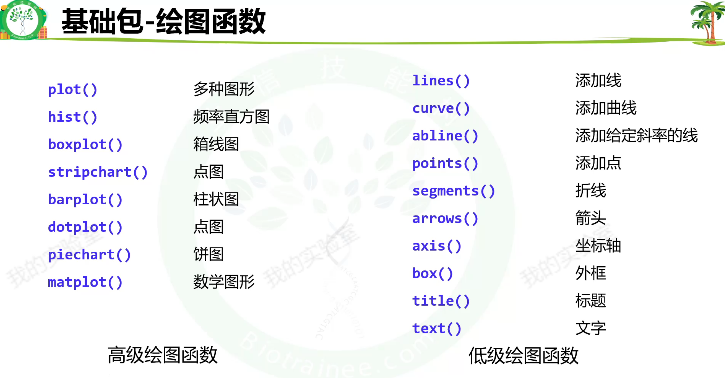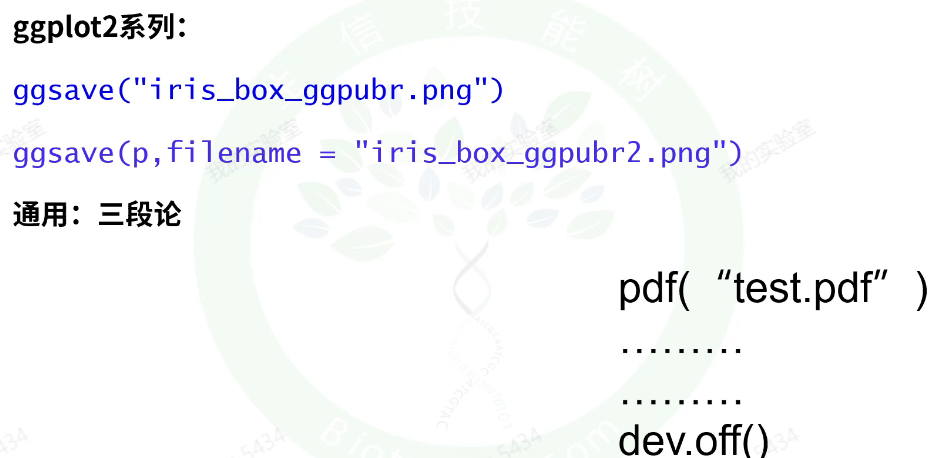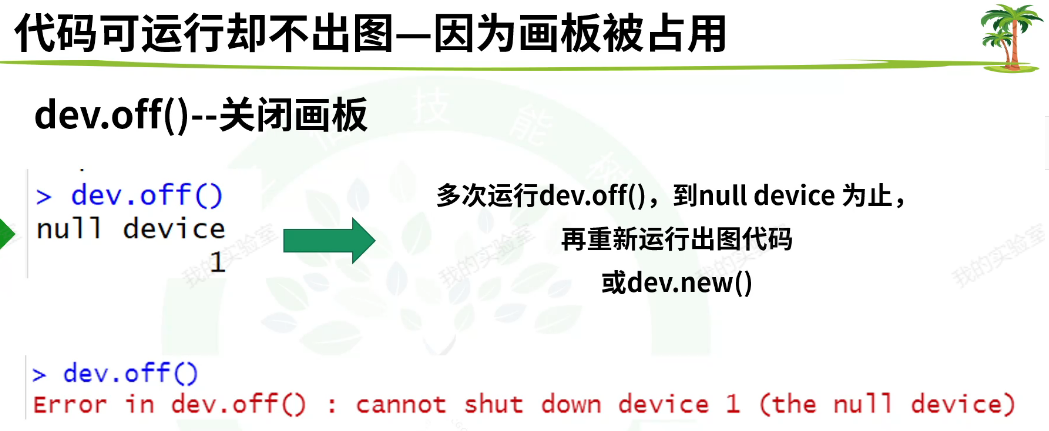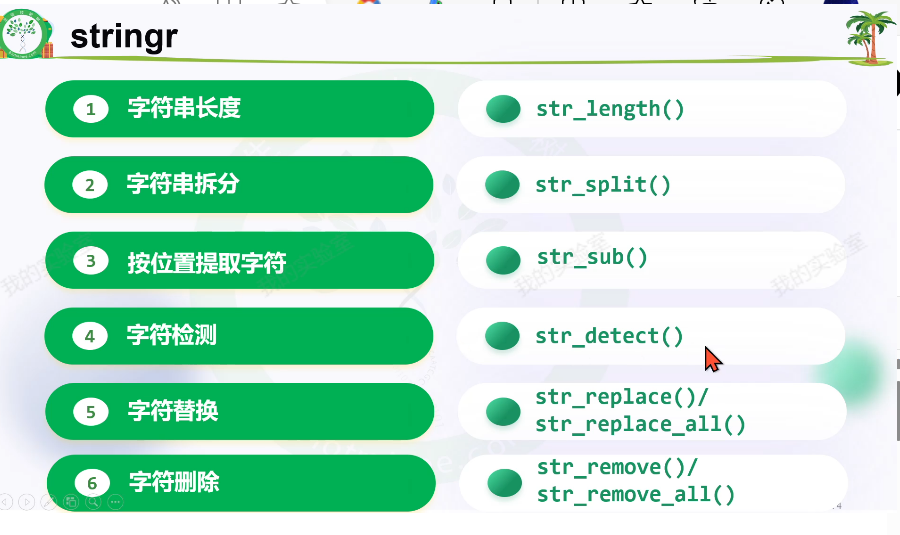R语言基础5(绘图基础)
原创常用可视化R包和函数
1,作图
base
ggplot2
ggpubr
2,拼图
par里的mfrow
grid.arrange
cowplot
patchwork
3,导出
经典三段论
ggsave
eoffice——topptx
绘图

基础包
plot(iris[,1],iris[,3],col = iris[,5])
text(6.5,4, labels = 'hello')
dev.off() #关闭画板ggplot2
library(ggplot2)
#1.入门级绘图模板:作图数据,横纵坐标
ggplot(data = iris)+
geom_point(mapping = aes(x = Sepal.Length,
y = Petal.Length))
#列名不添加引号
#两个函数用+连接
#2.属性设置(颜色、大小、透明度、点的形状,线型等)
#2.1 手动设置,需要设置为有意义的值
ggplot(data = iris) +
geom_point(mapping = aes(x = Sepal.Length,
y = Petal.Length),
color = "blue")
ggplot(data = iris) +
geom_point(mapping = aes(x = Sepal.Length, y = Petal.Length),
size = 5, # 点的大小5mm
alpha = 0.5, # 透明度 50%
shape = 8) # 点的形状
##颜色:字符串,blue, red等;
#2.2 映射:按照数据框的某一列来定义图的某个属性
ggplot(data = iris)+
geom_point(mapping = aes(x = Sepal.Length,
y = Petal.Length,
color = Species))
#color是aes的参数,则选列名,color是geom_point的参数则为具体颜色;
## Q1 能不能自行指定映射的具体颜色?
ggplot(data = iris)+
geom_point(mapping = aes(x = Sepal.Length,
y = Petal.Length,
color = Species))+
scale_color_manual(values = c("blue","grey","red"))
## Q2 区分color和fill两个属性
### Q2-1 空心形状和实心形状都用color设置颜色
ggplot(data = iris)+
geom_point(mapping = aes(x = Sepal.Length,
y = Petal.Length,
color = Species),
shape = 17) #17号,实心的例子
ggplot(data = iris)+
geom_point(mapping = aes(x = Sepal.Length,
y = Petal.Length,
color = Species),
shape = 2) #2号,空心的例子
### Q2-2 既有边框又有内心的,才需要color和fill两个参数
ggplot(data = iris)+
geom_point(mapping = aes(x = Sepal.Length,
y = Petal.Length,
color = Species),
shape = 24,
fill = "black") #24号,双色的例子
#3.分面
ggplot(data = iris) +
geom_point(mapping = aes(x = Sepal.Length, y = Petal.Length)) +
facet_wrap(~ Species)
#双分面
dat = iris
dat$Group = sample(letters[1:5],150,replace = T)
###新增一列,sample表示抽样;
ggplot(data = dat) +
geom_point(mapping = aes(x = Sepal.Length, y = Petal.Length)) +
facet_grid(Group ~ Species)
#4.几何对象
#局部设置和全局设置
ggplot(data = iris) +
geom_smooth(mapping = aes(x = Sepal.Length,
y = Petal.Length))+
geom_point(mapping = aes(x = Sepal.Length,
y = Petal.Length))
###局部设置
ggplot(data = iris,mapping = aes(x = Sepal.Length, y = Petal.Length))+
geom_smooth()+
geom_point()
###全局设置
#5.统计变换-条形图
View(diamonds)
table(diamonds$cut)
ggplot(data = diamonds) +
geom_bar(mapping = aes(x = cut))
ggplot(data = diamonds) +
stat_count(mapping = aes(x = cut))
#统计变换使用场景
#5.1.不统计,数据直接做图
fre = as.data.frame(table(diamonds$cut))
fre
ggplot(data = fre) +
geom_bar(mapping = aes(x = Var1, y = Freq), stat = "identity")
#5.2count改为prop(比例))
ggplot(data = diamonds) +
geom_bar(mapping = aes(x = cut, y = after_stat(prop), group = 1))
#6.位置关系
# 6.1抖动的点图
ggplot(data = iris,mapping = aes(x = Species,
y = Sepal.Width,
fill = Species)) +
geom_boxplot()+
geom_point()
ggplot(data = iris,mapping = aes(x = Species,
y = Sepal.Width,
fill = Species)) +
geom_boxplot()+
geom_jitter()
# 6.2 条形图
ggplot(data = diamonds) +
geom_bar(mapping = aes(x = cut,fill=clarity))
ggplot(data = diamonds) +
geom_bar(mapping = aes(x = cut,fill = clarity),
position = "fill")
ggplot(data = diamonds) +
geom_bar(mapping = aes(x = cut, fill = clarity),
position = "dodge")
#7.坐标系
bar <- ggplot(data = diamonds) +
geom_bar(mapping = aes(x = cut, fill = cut),
width = 1) +
theme(aspect.ratio = 1) +
labs(x = NULL, y = NULL)
bar
bar + coord_flip()#翻转coord_flip()
bar + coord_polar()#极坐标系coord_polar()作业

library(ggplot2)
ggplot(data = iris)+
geom_violin(mapping = aes(x = Species,
y = Sepal.Width,
fill = Species))+
scale_color_manual(values = c("pink","green","blue"))+
geom_boxplot(mapping = aes(x = Species,
y = Sepal.Width))+
geom_jitter(mapping = aes(x = Species,
y = Sepal.Width,
shape=Species))+
coord_flip()
library(ggplot2)
ggplot(data = iris,aes(x = Species,
y = Sepal.Width))+
geom_violin(aes(fill = Species))+
scale_color_manual(values = c("pink","green","blue"))+
geom_boxplot()+
geom_jitter(aes(shape=Species))+
coord_flip()ggpubr
# ggpubr 搜代码直接用,基本不需要系统学习
# sthda上有大量ggpubr出的图
library(ggpubr)
ggscatter(iris,x="Sepal.Length",
y="Petal.Length",
color="Species")
p <- ggboxplot(iris, x = "Species",
y = "Sepal.Length",
color = "Species",
shape = "Species",
add = "jitter")
p
my_comparisons <- list( c("setosa", "versicolor"),
c("setosa", "virginica"),
c("versicolor", "virginica") )
p + stat_compare_means(comparisons = my_comparisons)+ # Add pairwise comparisons p-value
stat_compare_means(label.y = 9) 图片保存

#1.基础包作图的保存
pdf("iris_box_ggpubr.pdf")
boxplot(iris[,1]~iris[,5])
text(6.5,4, labels = 'hello')
dev.off()
#2.ggplot系列图(包括ggpubr)通用的简便保存 ggsave
p <- ggboxplot(iris, x = "Species",
y = "Sepal.Length",
color = "Species",
shape = "Species",
add = "jitter")
ggsave(p,filename = "iris_box_ggpubr.png")
#3.eoffice包 导出为ppt,全部元素都是可编辑模式
library(eoffice)
topptx(p,"iris_box_ggpubr.pptx")
###超多的点或行列的热图不适用,PPT会卡顿。
#https://mp.weixin.qq.com/s/p7LLLvzR5LPgHhuRGhYQBQ拼图


可以在STHA网站找到现成的代码。

画图的思维:
1、我的数据适合什么图展示?
2、搜索画图代码
3、仿制示例数据
4、套代码,调整细节
玩转字符串
str_length()
length()#向量里面元素的个数
str_split()
str_sub(x,5,9)#提取5-9的元素
str_detect(x,"h")##是否含有关键词h,生成与X长度相等的逻辑值向量,可用于向量取子集;
str_detect(x,"h|s")##是否含有关键词h或者s,生成与X长度相等的逻辑值向量,可用于向量取子集;
str_starts(x,"h")##是否以h开头,生成与X长度相等的逻辑值向量,可用于向量取子集;
str_ends(x,"h")##是否以h结束,生成与X长度相等的逻辑值向量,可用于向量取子集;
str_replace(x,"o","a")#将x中的o替换为a,只替换出现的第一个o;
str_replace(x,"o|s","a")#将x中的o或者s替换为a,只替换出现的第一个o;
str_replace_all(x,"o","a")#将x中的o替换为a,替换所有的o;
str_remove(x," ")##将x中的第一个空格删除;
str_remove_all(x," ")##将x中的全部空格删除;

library(stringr)
str_split(x," ")##按照空格分隔
str_split(x," ",simplify=T)##列表简化为矩阵玩转数据框
# arrange,数据框按照某一列排序
sort()##只排序某一列,其他列不改变;无法改变对应关系。
library(dplyr)
arrange(test, Sepal.Length) #将Sepal.LengthSepal.Length这一列从小到大排序
arrange(test, desc(Sepal.Length)) #从大到小
# distinct,数据框按照某一列去重复
distinct(test,Species,.keep_all = T)##将Species列去重复,保留所有列;
# mutate,数据框新增一列
mutate(test, new = Sepal.Length * Sepal.Width)
test$new= .....
##筛选行列
select()
filter()
# 连续的步骤
# 1.多次赋值,产生多个中间的变量
x1 = select(iris,-5)
x2 = as.matrix(x1)
x3 = head(x2,50)
pheatmap::pheatmap(x3)
# 2. 嵌套,代码不易读
pheatmap::pheatmap(head(as.matrix(select(iris,-5)),50))
# 3.管道符号传递,简洁明了
iris %>%
select(-5) %>%
as.matrix() %>%
head(50) %>%
pheatmap::pheatmap()
##将管道符前面所有的结果传递给后面的函数,作为他的第一个参数
#用之前需要加载stringr包或dplyr包,快捷键ctrl+shift+M条件或循环
rm(list = ls())
## 一.条件语句
###1.if(){ }
#### (1)只有if没有else,那么条件是FALSE时就什么都不做
i = -1
if (i<0) print('up')
if (i>0) print('up')
#理解下面代码
if(!require(tidyr)) install.packages('tidyr')
#### (2)有else
i =1
if (i>0){
print('+')
} else {
print("-")
}
i = 1
ifelse(i>0,"+","-")
ifelse(x,yes,no)
x:逻辑值或逻辑向量;
yes:逻辑值为TRUE时的返回值
no:逻辑值为FALSE时的返回值
x = rnorm(3)
x
ifelse(x>0,"+","-")
#ifelse()+str_detect(),王炸
samples = c("tumor1","tumor2","tumor3","normal1","normal2","normal3")
k1 = str_detect(samples,"tumor");k1
ifelse(k1,"tumor","normal")
k2 = str_detect(samples,"normal");k2
ifelse(k2,"normal","tumor")
#### (3)多个条件
i = 0
if (i>0){
print('+')
} else if (i==0) {
print('0')
} else if (i< 0){
print('-')
}
library(dplyr)
i = 0
case_when(i>0 ~ "+",
i<0 ~ "-",
T ~ "0")
options(scipen = 20)
x = c(0.01,0.001,0.07,0.03,0.00001)
x
?ggpubr::stat_compare_means
case_when(x <= 0.0001~"****",
x <= 0.001 ~"***",
x <= 0.01 ~ "**",
x <= 0.05 ~ "*",
T ~"ns"
)
ifelse(i>0,"+",ifelse(i<0,"-","0"))
## 二、for循环
for( i in 1:4){
print(i)
}
#批量画图
par(mfrow = c(2,2))
for(i in 1:4){
plot(iris[,i],col = iris[,5])
}
#批量装包
pks = c("tidyr","dplyr","stringr")
for(g in pks){
if(!require(g,character.only = T))
install.packages(g,ask = F,update = F)
}
# 隐式循环
apply(x, margin, fun, ...)
#x是数据框或者矩阵
#margin为行则是1,margin为列是2;
#fun为函数
#apply(test,2,mean)
#对test的每一列求平均值
sort(x)
#对x从小到大排序
head(x)
tail(x)
tail(x,1000)
#对x取前五或者后五;
identical(x1,x2)#判断x1和x2是否完全一致;
##举例
load(file="test2.Rdata")
a=apply(test,1,var)
x1=names(tail(sort(a),1000))
library(stringr)
x2=test %>%
apply(1,var) %>%
sort() %>%
tail(1000) %>%
names()
identical(x1,x2)
## 向量、列表的隐式循环——lappy
lappy(list,FUN, ...)
#对列表向量中的每个元素实施相同的操作
lappy(1:4,rnorm)两个数据框的连接
#inner_join:取交集
#full_join:全连接
#left_join:左连接
#right_join:右链接
表达矩阵画箱线图——数据的格式转化
# 表达矩阵
set.seed(10086)#生成随机数,随机种子为10086
exp = matrix(rnorm(18),ncol = 6)
exp = round(exp,2)##保留两位小数;round(exp)为取整;
rownames(exp) = paste0("gene",1:3)
colnames(exp) = paste0("test",1:6)
exp[,1:3] = exp[,1:3]+1
exp
library(tidyr)
library(tibble)
library(dplyr)
dat = t(exp) %>%
as.data.frame() %>%
rownames_to_column() %>%
mutate(group = rep(c("control","treat"),each = 3))
pdat = dat%>%
pivot_longer(cols = starts_with("gene"),###cols=2:4
names_to = "gene",##合并为一列,列名为gene
values_to = "count")##合并为一列,列名为count
###pivot_longer宽变长
library(ggplot2)
p = ggplot(pdat,aes(gene,count))+
geom_boxplot(aes(fill = group))+
theme_bw()
p
p + facet_wrap(~gene,scales = "free")一些函数
# 1.match-----
load("matchtest.Rdata")
x
y
## 如何把y的列名正确替换为x里面的ID?
## (1)分步解法
a = colnames(y)
b = x$file_name
k = match(a,b);k
#match(a,b)的意思是a里的每个元素在b的第几个位置上。
#是b的下标,可以给b取子集,也可以给与b对应的其他向量取子集。
colnames(y) = x$ID[k]
## (2)一步解法
load("matchtest.Rdata")
colnames(y) = x$ID[match(colnames(y),x$file_name)]
## (3)放弃match的解法
load("matchtest.Rdata")
rownames(x) = x$file_name
x = x[colnames(y),]
colnames(y) = x$ID
# 2.一些搞文件的函数----
dir() # 列出工作目录下的文件
dir(pattern = ".R$") #列出工作目录下以.R结尾的文件
file.create("douhua.txt") #用代码创建文件
file.exists("douhua.txt") #某文件在工作目录下是否存在
file.remove("douhua.txt") #用代码删除文件
file.exists("douhua.txt") #删掉了就不存在啦
## 可以批量的新建和删除
f = paste0("douhua",1:100,".txt")
file.create(f)
file.remove(f)
原创声明:本文系作者授权腾讯云开发者社区发表,未经许可,不得转载。
如有侵权,请联系 cloudcommunity@tencent.com 删除。
原创声明:本文系作者授权腾讯云开发者社区发表,未经许可,不得转载。
如有侵权,请联系 cloudcommunity@tencent.com 删除。
评论
登录后参与评论
推荐阅读
目录


